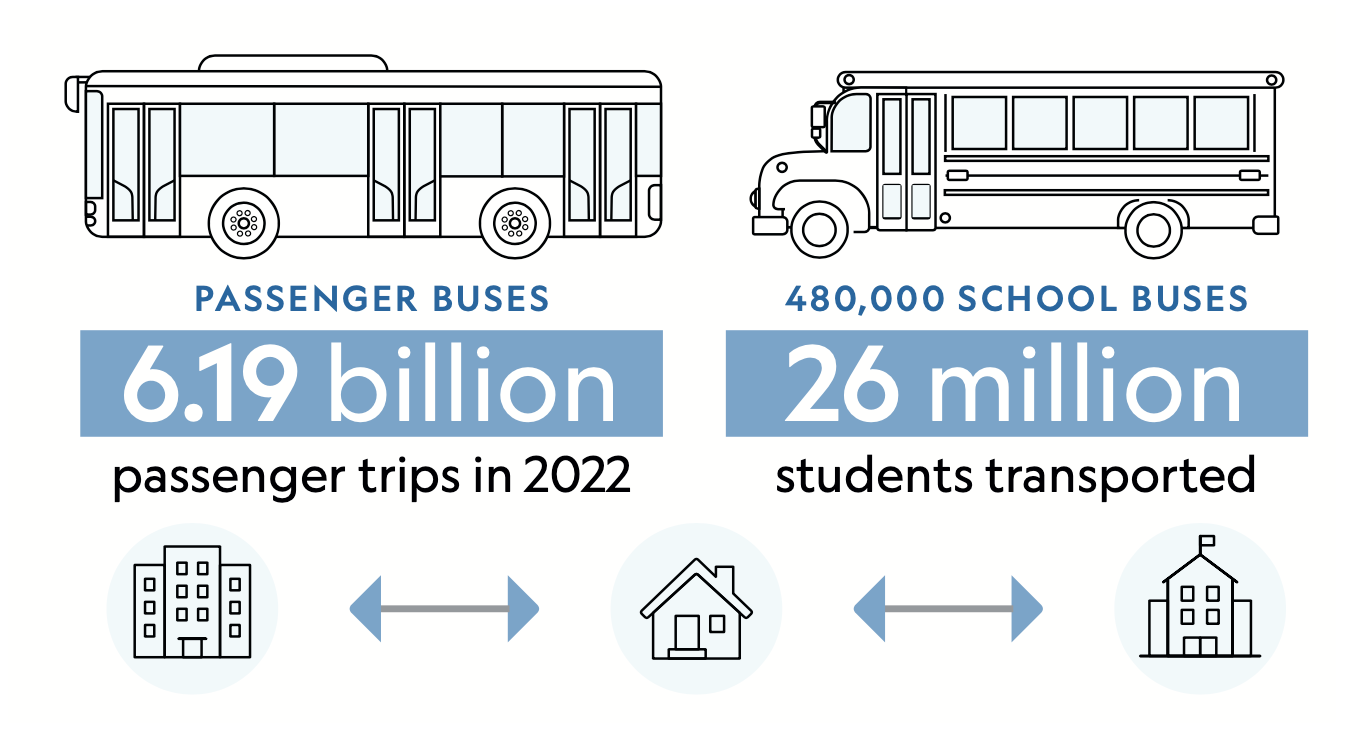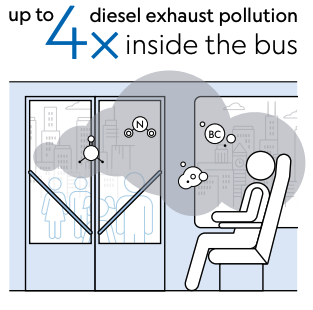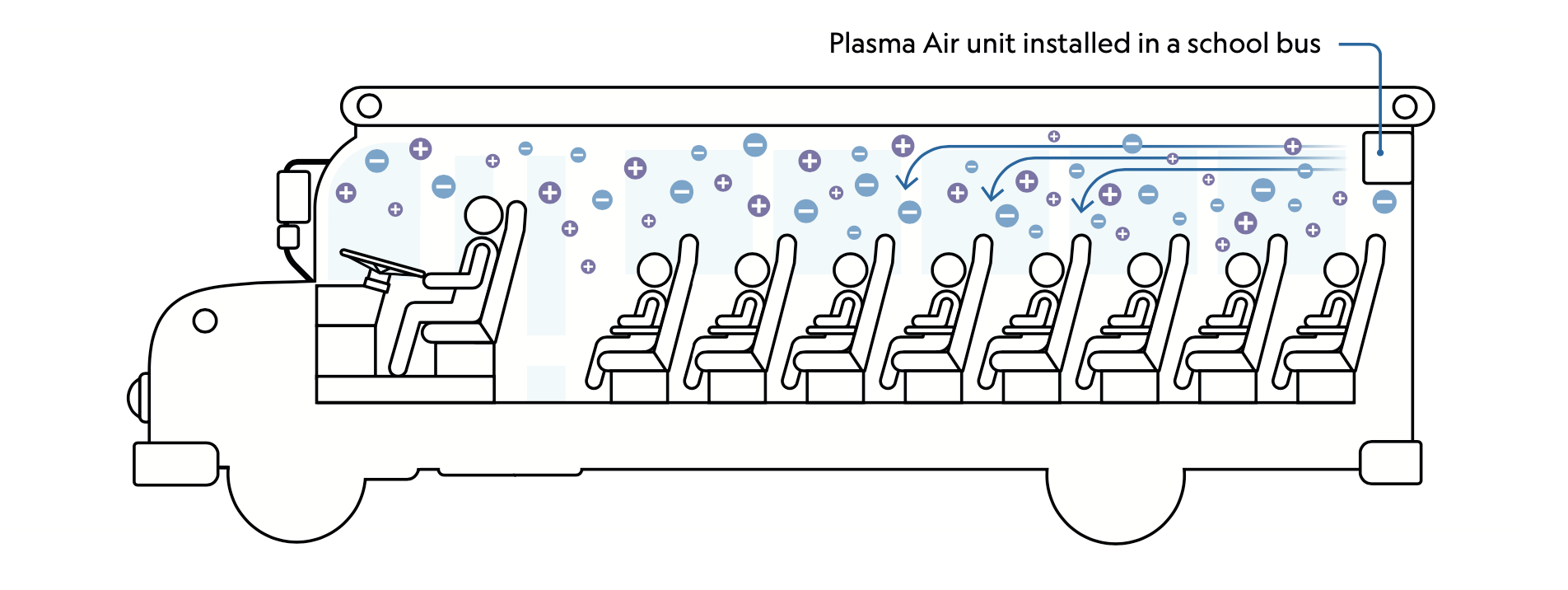Clean Air for Every Ride
Published
Plasma Air Improves Indoor Air Quality on Buses and Trains
Bus transportation plays a crucial role in our nation's logistics, serving as a lifeline for many. Public buses alone account for nearly half of all public transit trips, with approximately 6.19 billion passenger trips recorded in 2022, as reported by public transit authorities.1

Additionally, yellow school buses, constituting the largest public transportation fleet in the country, total over 480,000 and transport around 26 million students to and from schools, according to the NYSBCA2. Undoubtedly, buses are an indispensable mode of transportation for our nation.
THE IMPORTANCE OF CLEAN AIR INSIDE BUSES
While efforts to reduce pollution from bus emissions have been ongoing, the quality of indoor air inside buses often goes unnoticed. Bus exhaust, a known source of pollution, not only contributes to outdoor pollution, but also affects the air quality within the bus cabin.
Buses frequently idle at stops with open doors, allowing outdoor pollutants to enter the cabin, which can persist even after the doors are closed. Consequently, concentrations of pollutants such as fine and ultrafine particles (PM2.5 and UFPs, respectively), volatile organic compounds (VOCs), nitrogen dioxide (NO2), and black carbon in public transit can often exceed recommended levels.
Exposure to traffic-related air pollution, or TRAP, has been linked to increased health risks, including pulmonary and cardiovascular issues3 such as asthma exacerbation, reduced lung function, heart attacks, progression of atherosclerosis, cardiovascular mortality, and even cognitive impairment and poorer academic performance in students.4
Due to their chronic exposure to these pollutants, bus drivers and children, who are more vulnerable to the adverse effects of air pollution, face particular risks.
A study conducted by the U.S. Natural Resources Defense Council (NRDC) and the Coalition for Clean Air reveals that children riding a diesel school bus, which comprises 95% of all school buses in America, may be exposed to up to four times more toxic diesel exhaust than individuals standing or traveling beside the bus.5 Moreover, researchers estimated that a child on a diesel school bus could encounter 23 to 46 times the cancer risk considered "significant" by the U.S. Environmental Protection Agency (EPA).

AIR FILTRATION MECHANISMS ON BUSES
Buses typically employ filtration to purify their air. However, the effectiveness of these filters in removing harmful pollutants and pathogens varies depending on their specific type and rating. Unfortunately, the filters used in buses often have lower ratings, and overall ventilation tends to be inferior compared to other forms of transportation.6
"Bus heating, ventilation, and air-conditioning systems draw in outside air, filter it, and circulate it into the cabin or passenger area. It's a system that allows for a limited amount of fresh air intake," explains Mike Sherber, VP of Engineering at Plasma Air. "If the transportation system prioritizes maximum efficiency in cooling or heating the air within the cabin, it may reduce the air intake from outside, leading to higher concentrations of airborne pathogens and pollutants. Insufficient air mixing within the bus cabin can create an unsafe environment for prolonged exposure."
REVOLUTIONIZING AIR PURIFICATION ON BUSES
Enter Plasma Air, the game-changer in enhancing indoor air quality. Known for its success in purifying the air in buildings, schools, and homes, Plasma Air's technology is equally effective in mobile environments. By combining its soft ionization technology with ventilation and filters, Plasma Air offers a safe, comprehensive, and cost-efficient solution to improve indoor air quality as part of a multi-layered approach in buses.

Soft Ionization technology replicates nature's process of cleaning the air by producing positively and negatively charged oxygen ions that inactivate and reduce airborne pathogens and pollutants. Plasma Air's impact has already been felt in various bus systems across the country.
For example, the Kalamazoo, MI school district, comprised of 25 schools, prioritized the health of its students by installing Plasma Air’s 600 series air purifiers in all of its school buses during the pandemic. Additionally, Plasma Air's solutions were deployed throughout their schools, providing students and parents with the reassurance of a healthy environment both in and out of the classrooms.
Furthermore, Plasma Air's effectiveness in enhancing air quality extends beyond buses to other forms of transportation, such as trains.
In fact, a third-party study conducted on the Zaragoza tram system in Spain demonstrated that Plasma Air technology reduced the concentration of volatile organic compounds (VOCs) by an impressive 80%.7
DOWNLOAD THE FULL APPLICATION BRIEF
For inquiries regarding installation and customization to accommodate buses or trains of any size, please reach out to our sales team at info@wellairsolutions.com.
References:
1. Public transit in the United States - Statistics & Facts, Statista Research Department, Jun 22, 2023
2. School Bus Fast Facts, New York School Bus Contractors Association, Inc.
3. Human health effects of traffic-related air pollution (TRAP): a scoping review protocol, National Institutes of Health, Syst Rev. 2019; 8: 223, Published online 2019 Aug 29
4. The impact of Traffic-Related air pollution on child and adolescent academic Performance: A systematic review., Environment International, Volume 155, October 2021, 106696
5. No Breathing in the Aisles: Diesel Exhaust Inside School Buses, NRDC
6. Sophie Bushwick, Tanya Lewis, Amanda Montañez, Evaluating COVID Risk on Planes, Trains and Automobiles, Stay safer on different forms of transportation, Scientific American, November 19, 2020
7. Benjamin Beltran Bennasar, The Zaragoza Trams Study, MONSOLAR
